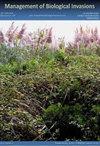一个专家驱动的框架,用于应用eDNA工具来改善南极的生物安全
IF 1.2
4区 环境科学与生态学
Q3 BIODIVERSITY CONSERVATION
引用次数: 0
摘要
《南极条约系统环境议定书》的签署国致力于防止非本地物种入侵南极洲,但系统的监测很少。环境DNA (Environmental DNA, eDNA)方法为加强非本地物种的检测和生物安全监测提供了新的机会。为了对南极生物安全有效,eDNA测试必须具有适当的敏感性和特异性,以区分南极本地物种和非本地物种,并且要符合目的。这需要了解eDNA监测将提供信息的优先风险物种或分类群体,对这些物种或群体进行验证的eDNA分析,以及目标非本地和相关本地南极物种的参考DNA序列。本文采用专家启发法和共识决策法,对澳大利亚南极计划(AAP)在东南极洲的优先生物安全风险进行了识别和评估,包括确定高优先级的非本地物种及其潜在的运输途径。我们确定生物安全监测的优先目标不是单个物种,而是更广泛的分类类群,如贻贝(Mytilus species)、被囊动物(Ascidiacea)、弹尾动物(Collembola)和禾本科(Poaceae)。这些类群中每一类都包括多种物种,它们被引入和/或在南极洲定居的风险很高。对于AAP来说,最合适的eDNA方法必须能够检测到这些高危人群中的一系列物种本文章由计算机程序翻译,如有差异,请以英文原文为准。
An expert-driven framework for applying eDNA tools to improve biosecurity in the Antarctic
Signatories to the Antarctic Treaty System’s Environmental Protocol are committed to preventing incursions of non-native species into Antarctica, but systematic surveillance is rare. Environmental DNA (eDNA) methods provide new opportunities for enhancing detection of non-native species and biosecurity monitoring. To be effective for Antarctic biosecurity, eDNA tests must have appropriate sensitivity and specificity to distinguish non-native from native Antarctic species, and be fit-for-purpose. This requires knowledge of the priority risk species or taxonomic groups for which eDNA surveillance will be informative, validated eDNA assays for those species or groups, and reference DNA sequences for both target non-native and related native Antarctic species. Here, we used an expert elicitation process and decision-by-consensus approach to identify and assess priority biosecurity risks for the Australian Antarctic Program (AAP) in East Antarctica, including identifying high priority non-native species and their potential transport pathways. We determined that the priority targets for biosecurity monitoring were not individual species, but rather broader taxonomic groups such as mussels ( Mytilus species), tunicates (Ascidiacea), springtails (Collembola), and grasses (Poaceae). These groups each include multiple species with high risks of introduction to and/or establishment in Antarctica. The most appropriate eDNA methods for the AAP must be capable of detecting a range of species within these high-risk groups (e
求助全文
通过发布文献求助,成功后即可免费获取论文全文。
去求助
来源期刊

Management of Biological Invasions
Agricultural and Biological Sciences-Ecology, Evolution, Behavior and Systematics
CiteScore
3.40
自引率
6.70%
发文量
21
审稿时长
16 weeks
期刊介绍:
Management of Biological Invasions, established in 2010 by Dr. Elias Dana, is an open access, peer-reviewed international journal focusing on applied research in biological invasions in aquatic and terrestrial ecosystems from around the world. This journal is devoted to bridging the gap between scientific research and the use of science in decision-making, regulation and management in the area of invasive species introduction and biodiversity conservation.
Managing biological invasions is a crisis science, with Management of Biological Invasions aiming to provide insights to the issues, to document new forms of detection, measurements and analysis, and to document tangible solutions to this problem.
In addition to original research on applied issues, Management of Biological Invasions publishes technical reports on new management technologies of invasive species and also the proceedings of relevant international meetings. As a platform to encourage informed discussion on matters of national and international importance, we publish viewpoint papers that highlight emerging issues, showcase initiatives, and present opinions of leading researchers.
 求助内容:
求助内容: 应助结果提醒方式:
应助结果提醒方式:


